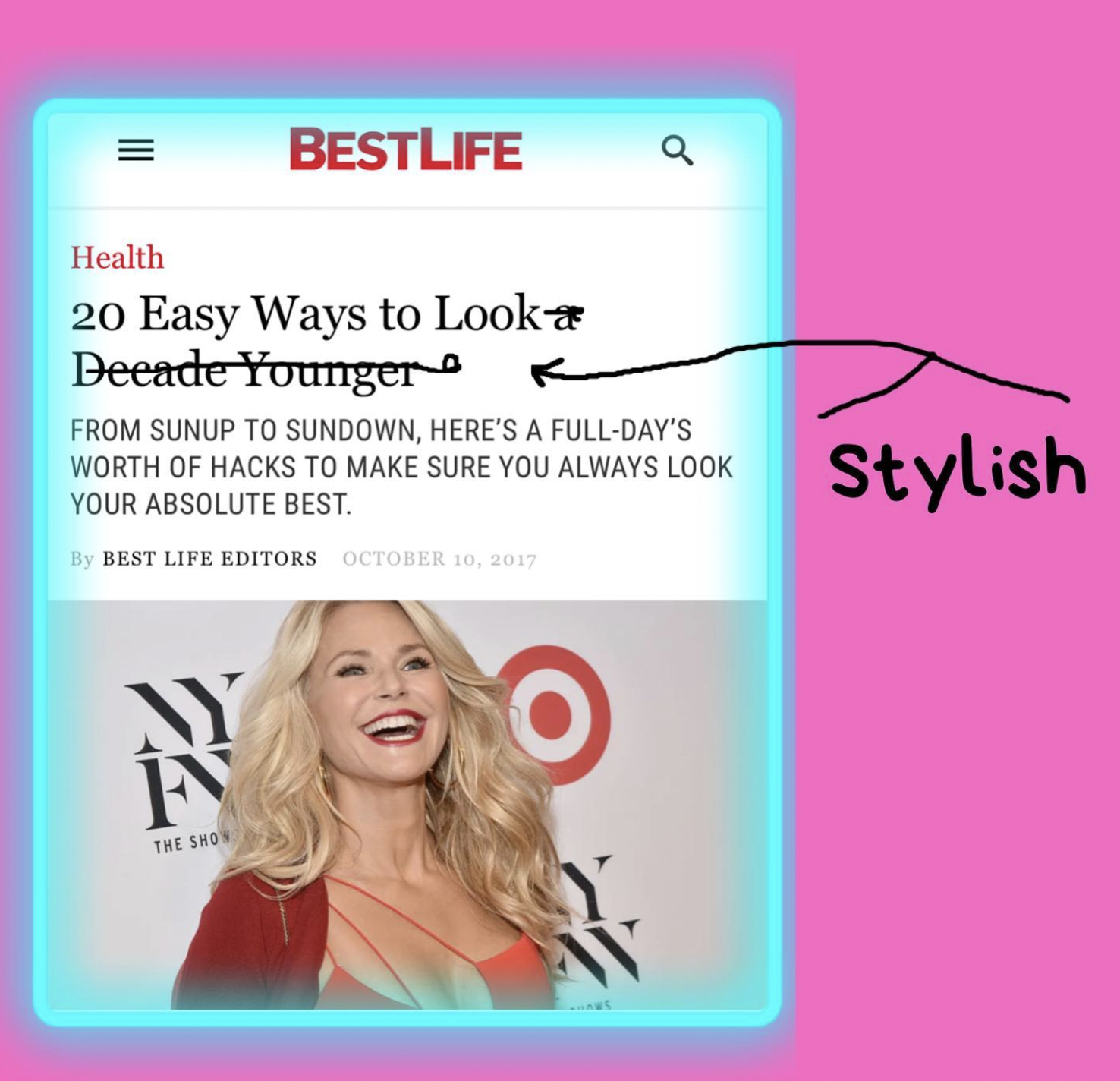Ending Ageism Creatively: Exposing Harmful Stereotypes of Older People
Can you spot the ageism in this headline for a health article in Best Life magazine?
“20 Easy Ways to Look a Decade Younger: From Sunup to Sundown, Here’s a Full-Day’s Worth of Hacks to Make Sure You Always Look Your Absolute Best”
Meg LaPorte says this kind of fear-based marketing targeting older adults is rampant. She believes it is not only offensive and demeaning, but also perpetuates stigma about age and aging.
In a post to her Instagram account, art_against_ageism, Meg took her editor’s pen to this headline, crossing out the words “a decade younger” and replacing them with ‘stylish’ an age-neutral term.
She posted, “Of course the entire article will likely need to be rewritten, given that the authors seem to equate looking younger with looking your best. Ageism makes us feel like we should look younger in order to look our best. Let’s reframe the anti-aging mindset to one of anti-ageism, in which we reject the notion that being stylish and attractive comes only with looking or being younger.”
Meg LaPorte is a journalist, editor, and communications specialist with more than 22 years of experience in the field of aging services. She is co-founder, with Jordan Evans, of Art Against Ageism, an alliance of creatives, artists, and activists whose work identifies, amplifies, and creates artistic endeavors that are anti-ageist.
Can We Talk About Ageism?
Ageism is prejudice or discrimination against people based on their age. It typically applies to people who are older but can also affect young people. Ageism has a negative impact on physical and mental health, and reports link it with earlier death. Although it is universal, people do not always take ageism as seriously as other forms of inequity.
I take ageism seriously, because I’m a personal trainer and movement educator whose clients are mostly women, and a few men, in their 60s, 70s and 80s. Some of them have been told, directly or indirectly, by healthcare providers, friends, family that they are too old or it’s too late for their bodies to function well and feel great. Sometimes they even tell this to themselves!
Ageism can be embedded in policies (joint replacements recommended only up until a certain age) or used to promote products purported to fix your body (expensive orthotics for foot pain, aging serum) or subtle and still oppressive (like a birthday card making a joke about wrinkles, fat, or incontinence).
Reframing the Anti-Aging Mindset
I found Meg LaPorte’s clever media platform Art Against Ageism on Instagram, while searching the hashtag #aging. No surprise, the top result was “anti aging.” Despite only 6% of the audience being 55 and older, there are a growing number of accounts that focus on aging in a positive way. I’m sure you know Sixty and Me by Margaret Manning. :) I’ll list a few more of my favorites at the end of this article.
I interviewed Meg via Zoom about how she’s hoping to “reframe the anti-aging mindset to one of anti-ageism.”
She says she “fell in love” with writing about aging during assignments where she was able to interview many kinds of people who work and live in assisted living communities and nursing homes, “everybody from the CEO to director of nursing to seniors themselves.”
In Meg’s opinion, “Senior living communities probably need the most work on ageism because you've got not just older adults, but also people who are caring for them. And the more they know about ageism and preconceived conceptions and stereotypes about older people, the better” we can work together to help combat it.
In 2015, as a freelance writer, Meg launched a blog called “Age in America,” focused on challenging the stereotypes of older adults by telling their stories in their own words. “It really was a way for me to just discover really interesting things about people and meet people.”
A Creative Approach to Calling Out Ageism
Ageism is everywhere. And these days, Meg continues to draw attention to it through her posts. She’s #fixed articles from HuffPost, Town&Country and Reader’s Digest. As a former news editor myself, I understand the power of the pen! Her work creatively illuminates the ways advertising often targets readers of a certain age, and also discriminates against them in the same headline.
A few months back, she called out AARP for publishing a review of the book Cheat the Clock: A New Book Finds a Path to Maintain Your Youthful Look. Since then, she’s been informed that this review was from eight years ago. She updated her original post with an acknowledgement. “AARP seems to have slowed or even stopped these types of ageist headlines...My apologies, as it seems the organization has taken its own advice.”
Can you spot the anti-ageism on social media? Follow Art_against_ageism and these anti-ageist Instagram accounts and see for yourself:
EFF THEIR AGING STANDARDS™
How and when do you feel the effects of ageism? Do you look for information about aging and ageism on social media? Which accounts do you trust, follow and share?
This article was originally published on Sixty and Me.
Let me remind you to move! Subscribe to the Aging Well newsletter.


